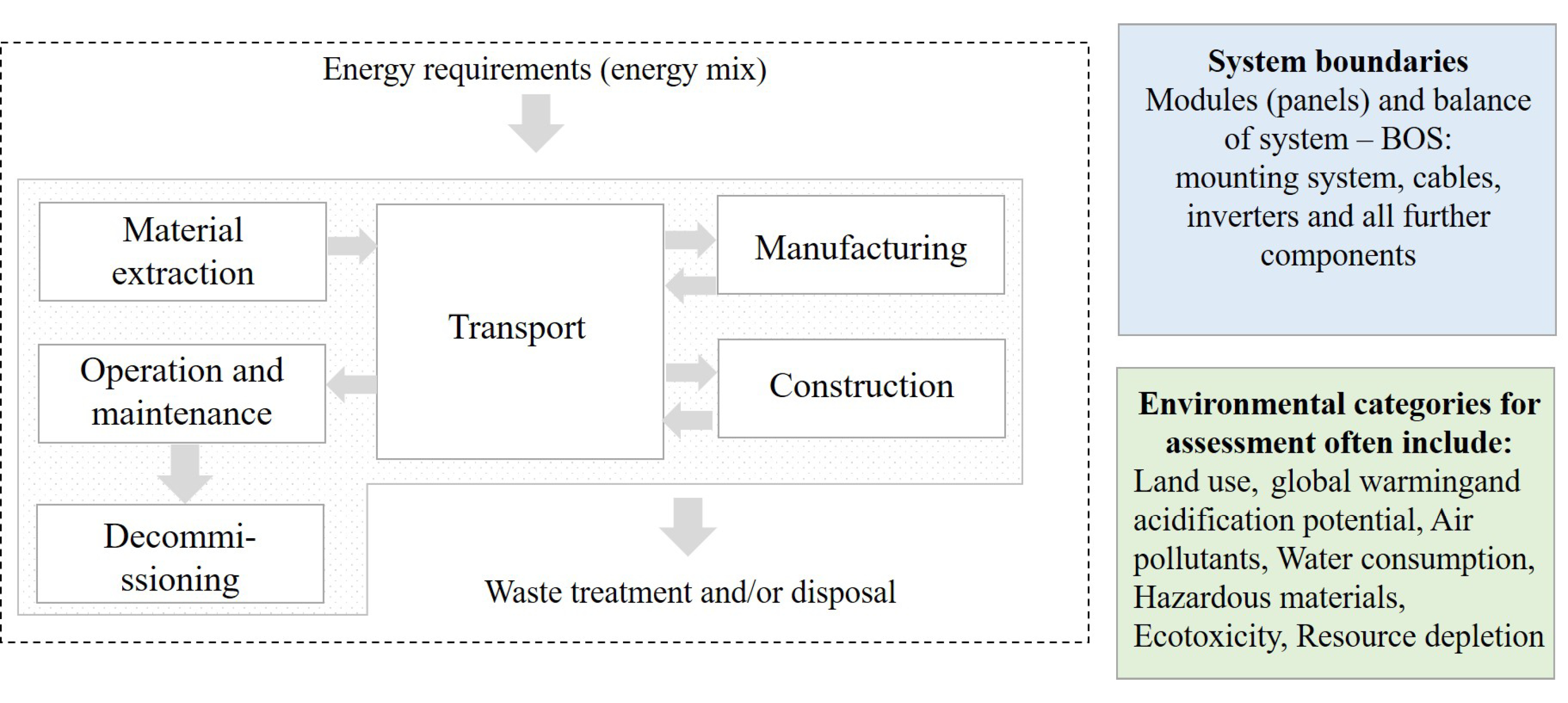Impactos ambientales de sistemas de energía solar fotovoltaica: una revisión de análisis de ciclo de vida y otros estudios.
Environmental impacts of solar photovoltaic systems: a revision from Life Cycle Assessments and other studies
Barra lateral del artículo

Términos de la licencia (VER)

Esta obra está bajo una licencia internacional Creative Commons Atribución-NoComercial-SinDerivadas 4.0.
Declaración del copyright
Los autores ceden en exclusiva a la Universidad EIA, con facultad de cesión a terceros, todos los derechos de explotación que deriven de los trabajos que sean aceptados para su publicación en la Revista EIA, así como en cualquier producto derivados de la misma y, en particular, los de reproducción, distribución, comunicación pública (incluida la puesta a disposición interactiva) y transformación (incluidas la adaptación, la modificación y, en su caso, la traducción), para todas las modalidades de explotación (a título enunciativo y no limitativo: en formato papel, electrónico, on-line, soporte informático o audiovisual, así como en cualquier otro formato, incluso con finalidad promocional o publicitaria y/o para la realización de productos derivados), para un ámbito territorial mundial y para toda la duración legal de los derechos prevista en el vigente texto difundido de la Ley de Propiedad Intelectual. Esta cesión la realizarán los autores sin derecho a ningún tipo de remuneración o indemnización.
La autorización conferida a la Revista EIA estará vigente a partir de la fecha en que se incluye en el volumen y número respectivo en el Sistema Open Journal Systems de la Revista EIA, así como en las diferentes bases e índices de datos en que se encuentra indexada la publicación.
Todos los contenidos de la Revista EIA, están publicados bajo la Licencia Creative Commons Atribución-NoComercial-NoDerivativa 4.0 Internacional
Licencia
![]()
Esta obra está bajo una Licencia Creative Commons Atribución-NoComercial-NoDerivativa 4.0 Internacional
Contenido principal del artículo
Resumen
Según el séptimo objetivo de desarrollo sostenible (ODS) concluido por la Organización de las Naciones Unidas (ONU), la energía deberá ser limpia y accesible para todos en las próximas décadas. La energía limpia se utiliza a menudo como sinónimo de energía renovable (ER), sostenible o verde, palabras que se asocian con un concepto de tecnologías de bajo impacto ambiental (IA). Sin embargo, las ERs también tienen asociados IAs negativos, que pueden identificarse y evaluarse mediante instrumentos como la Evaluación de Impactos Ambientales (EIA) o el Análisis de ciclo de vida (ACV). Este artículo se centra en la revisión de los IAs documentados en diferentes ACV para sistemas de energía solar fotovoltaica (SEPV), el tipo más común de ERs modernas para satisfacer la demanda energética a nivel mundial.
Aunque diferentes estudios de ACV incluyen varias categorías ambientales de evaluación, para el análisis se seleccionaron 5 categorías, potencial de calentamiento global (GWP, por sus siglas en inglés), uso del suelo, pérdida de biodiversidad, salud humana y generación de residuos.
Los resultados muestran que los IAs de los SEPV documentados en ACVs dependen no solo de la tecnología, el contexto y la escala del proyecto, sino también del objetivo y alcance de cada estudio. Aun así, este artículo recoge valores orientativos para el GWP, el uso de suelo y los accidentes mortales de aves relacionados con SEPV. Además, la investigación revela la necesidad de enfoques complementarios como EIA o estudios de toxicidad para poder dimensionar impactos acerca de pérdida de biodiversidad y daños a la salud humana, así mismo concluye la falta de un sistema de gestión de residuos adecuado para las miles de toneladas que generarán estos sistemas a futuro.
Descargas
Detalles del artículo
Alba Sánchez Coria, Autor
Estudiante de ingeniería ambiental Universidad Técnica de Darmstadt, Alemania.
Estudiante de pasantía de ingeniería ambiental, Escuela Colombiana de Ingeniería Julio Garavito
Referencias (VER)
Alsema, E.; de Wild-Scholten, M. J. (2007). Keep it clean. Reducing environmental impacts from solar PV. Renewable Energy World, pp. 96-103.
Anak John, C.; See Tan, L.; Tan, J.; Loo Kiew, P.; Mohd Shariff, A.; Abdul Halim, H. N. (2021). Selection of Renewable Energy in Rural Are Via Life Cycle Assessment-Analytical Hierarchy Process (LCA.AHP): A Case Study of tatau, Sarawak. Sustainability, 13(21), 1880. DOI: 10.3390/su132111880.
Antonanzas, J.; Quinn, J. C. (2021). Net environmental impact of the PV industry from 2000-2025. Journal of Cleaner Production, 311, 127791. DOI: 10.1016/j.jclepro.2021.127791
Balfour, J. R.; Shaw, M.; Bremer Nash, N. (2011). Introduction to Photovoltaic System Design. Burlington, Jones & Bartlett Publishers, pp. 2-6.
Bakhiyi, B.; Labrèche, F.; Zayed, J. (2014). The photovoltaic industry on the path to a sustainable future - environmental and occupational health issues. Environmental International, 73, pp. 224-234. DOI: 10.1016/j.envint.2014.07.023
Chowdhury, Md. S.; Rahman, K. S.; Chowdhury, T.; Nuthammachot, N.; Techato, K.; Akhtaruzzaman; Tiong, S. K.; Kamaruzzaman, S.; Nowshad, A. (2020): An overview of solar photovoltaic panels’ end-of-life material recycling. Energy Strategy Reviews, 27, pp. 100431. DOI: 10.1016/j.esr.2019.100431.
Cornejo, F.; Janssen, M.; Gaudrealt, C.; Samson, R. (2005): Using Life Cycle Assessment (LCA) as a Tool to Enhance Environmental Impact Assessment (EIA). Chemical Engineering Transaction, 7, pp. 521- 528.
Da Pimentel Silva, G. D.; Branco, D. A. C. (2018). Is floating photovoltaic better than conventional photovoltaic? Assessing environmental impacts. Impact Assessment and Project Appraisal, 36 (5), pp. 390-400. DOI: 10.1080/14615517.2018.1477498.
Dhar, A.; Naeth, M. A.; Jennings, P. D.; El-Din, M. G. (2020). Perspectives on environmental impacts and a land reclamation strategyfor solar and wind energy systems. Science of the Total Environment, 718, pp. 134602. DOI: 10.1016/j.scitotenv.2019.134602
Domínguez, A.; Geyer, R. (2017). Photovoltaic waste assessment in Mexico. Resource, Conservation and Recycling, 127, pp. 29-41. DOI: 10.1016/j.resconrec.2017.08.013
Dubey, S.; Jadhav, N. Y.; Zakirova, B. (2013). Socio-Economic and Environmental Impacts of Silicon Based Photovoltaic (PV) Technologies. Energy Procedia, 33, pp. 322-334. DOI: 10.1016/j.egypro.2013.05.073.
Dupraz, C.; Marrou, H.; Talbot, G.; Dufour, L.; Nogier, A.; Ferard, Y. (2011). Combining solar photovoltaic panels and food crops for optimising land use: Towards new agrivoltaic schemes. Renewable Energy, 36 (10), pp. 2725-2732. DOI: 10.1016/j.renene.2011.03.005.
Edenhofer, O.; Pichs Madruga, R.; Sokona, Y. (2012): Renewable energy sources and climate change mitigation. Special report of the Intergovernmental Panel on Climate Change, New York, Cambridge University Press.
European Commission (2012): Waste from Electrical and Electronic Equipment (WEEE). [Online]. Available at: https://ec.europa.eu/environment/topics/waste-and-recycling/waste-electrical-and-electronic-equipment-weee_de.
Fraunhofer Institute for Solar Energy Systems (2021). Photovoltaics report. [Online]. Available at: https://www.ise.fraunhofer.de/content/dam/ise/de/documents/publications/studies/Photovoltaics-Report.pdf
Food and Agriculture Organization of the UN. FAO (2014). The Water-energy-Food Nexus. A new approach in support of food security and sustainable agriculture.
Forti, V.; Baldé, C.P.; Kuehr, R.; Bel, G. (2020). The Global E-waste Monitor 2020: Quantities, flows and the circular economy potential. United Nations University (UNU)/United Nations Institute for Training and Research (UNITAR) – co-hosted SCYCLE Programme, International Telecommunication Union (ITU) & International Solid Waste Association (ISWA), Bonn/Geneva/Rotterdam.
Fthenakis, V.; Kim, H. C.; Frischknecht, R.; Raugei, M.; Sinha, P.; Stucki, M. (2011). Life cycle inventories and life cycle assessment of photovoltaic systems, New York, International Energy Agency.
Fthenakis, V.; Kim, H. C. (2009). Land use and electricity generation: A life-cycle analysis. Renewable and Sustainable Energy Reviews, 13 (6-7), pp. 1465-1474. DOI: 10.1016/j.rser.2008.09.017.
Hernandez, R. R.; Murphy-Mariscal, M. I.; Easter, S. B.; Maestre, F. T.; Tavassoli, M.; Allen, E. B.; Barrows, C. W.; Belnap, J.; Ochoa-Hueso, R.; Ravi, S.; Allen, M. F. (2014). Environmental impacts of utility-scale solar energy. Renewable and Sustainable Energy Reviews, 29, pp. 766-779. DOI: 10.1016/j.rser.2013.08.041
Hong, J.; Chen, W.; Qi, C.;Ye, L.; Xu, C. (2016). Life cycle assessment of multicristalline silicon photovoltaic cell production in China. Solar Energy, 133, pp. 283-293. DOI: 10.1016/j.solener.2016.04.013
International Energy Agency (IEA). 2020. World energy outlook 2020. Online. Available at: https://iea.blob.core.windows.net/assets/a72d8abf-de08-4385-8711-b8a062d6124a/WEO2020.pdf
IEA (2021). Renewable Power. International Energy Agency. Available at: https://www.iea.org/reports/renewable-power
IEA, IRENA, UNSD, WBG, WHO (2019). Tracking SDG 7: The Energy progress report, Washington DC.
IFO (2015). Utility-Scale Solar Photovoltaic Power Plants. [Online]. Available at: https://www.ifc.org/wps/wcm/connect/a1b3dbd3-983e-4ee3-a67b-cdc29ef900cb/IFC+Solar+Report_Web+_08+05.pdf?MOD=AJPERES&CVID=kZePDPG
IRENA (2019), Future of Solar Photovoltaic: Deployment, investment, technology, grid integration and socio-economic aspects (A Global Energy Transformation: paper), International Renewable Energy Agency, Abu Dhabi. Available at: https://Irena.org/publications/2019/Nov/Future-of-Solar-Photovoltaic
IUCN ROWA (2019). Nexus comprehensive methodological framework: the MENA Region Initiative as a model of Nexus Approach and Renewable Energy Technologies (MINARET). Amman, Jordan: IUCN.
Kafka, J.; Miller, M.A. (2020). The dual angle solar harvest (DASH) method: An alternative method for organizing large solar panel arrays that optimizes incident solar energy in conjunction with land use. Renewable Energy, 155, pp. 531-546. DOI: 10.1016/j.renene.2020.03.025.
Kim, B.; Lee, J.; Kim, K.; Hur, T. (2013). Evaluation of the environmental performance of sc-Si and mc-SiPV systems in Korea. Solar Energy, pp, pp. 100-114. DOI: 10.1016/j.solener.2013.10.038
Kim, J. Y.; Koide, D.; Ishihama, F.; Kadoya, T.; Nishihiro, J. (2021). Current site planning of medium to large solar power systems acceleratesthe loss of the remaining semi-natural and agricultural habitats. Science of the Total Environment, 779, 146475. DOI: 10.1016/j.scitotenv.2021.146475.
Kosciuch, K.; Riser-Espinoza, D.; Gerringer, M.; Erickson, W. (2020). A summary of bird mortality at photovoltaic utility scale solar facilities in the Southwestern U.S. PLoS ONE, 15 (4). DOI: 10.1371/journal.pone.0232034.
Loss, S. R. (2016). Avian interactions with energy infrastructure in the context of other anthropogenic threats. The Condor, 118 (2), pp. 424-432. DOI: 10.1650/CONDOR-16-12.1.
Loss, S. R.; Will, T.; Marra, P. P. (2015). Direct Mortality of Birds from Anthropogenic Causes. Annual Reviw of Ecology, Evolution and Systatics, 46 (1), pp. 99-120. DOI: 10.1146/annurev-ecolsys-112414-054133.
Ludin, N. A.; Affandi, N. A. A.; Purvis-Roberts, K.; Ahmad, A.; Ibrahim, M. A.; Sophian, K.; Jusoh, S. (2021). Environmental Impact and Levelised Cost of Energy Analysis of Solar Photovoltaic Systems in Selected Asia Pacific Region: A Cradle-to-Grave Approach. Energy, 13(1), pp. 396. DOI: 10.3390/su13010396
Magrassi, F.; Rocco, E.; Barberis, S.; Gallo, M.; Del Borghi, A. (2018). Hybrid solar poewr system versus photovoltaic plant: A comparative analysis though a life cycle approach. Renewable Energy, 130, pp. 290-304. DOI: 10.1016/j.renene.2018.06.072.
Mahmoudi, S.; Huda, N.; Behnia, M. (2021). Critical assessment of renewable energy waste generation in OECD countries: Decommissioned PV panels. Resources, Conservation and Recycling 164, pp. 105145. DOI: 10.1016/j.resconrec.2020.105145.
Mérida García, A; Gallagher, J.; McNabola, A.; Camacho Poyato, E.; Montesinos Barrios, P.; Rodríguez Díaz, J.A. (2019). Comparing the environmental and economic impacts of on- or off-grid solar photovoltaics with traditional energy sources for rural irrigation systems. Renewable Energy, 140, pp. 895-904. DOI: 10.1016/j.renene.2019.03.122.
Muteri, V.; Cellura, M.; Curto, D.; Franzitta, V.; Longo, S.; Mistretta, M.; Parisi, M. L. (2020). Review on Life Cycle Assessment of Soar Photovoltaic Panels. Eergies, 13 (1), pp.252. DOI: 10.3390/en13010252
Müller, A.; Friedrich, L.; Reichel, C.; Herceg, S.; Mittag, M.; Neuhaus, D. H. (2021). A comparative life cycle assessment of silicon PV modules: Impact of module design, manufacturing location and inventory. Solar energy Materials and Solar Cells, 230, 111277. DOI: 10.1016/j.solmat.2021.111277
North Carolina State University (2017). Health and Safety Impacts of Solar Photovoltaics. [Online]. Available at: https://nccleantech.ncsu.edu/wp-content/uploads/2018/10/Health-and-Safety-Impacts-of-Solar-Photovoltaics-2017_white-paper.pdf
Ong, P.; Campbell, C.; Denholm, P.; Margolis, R.; Heath, G. (2013). Land-Use Requirements for Solar Power Plants in the United States. Available at: https://www.nrel.gov/docs/fy13osti/56290.pdf
Peng, J.; Lu, L.; Yang, H.; (2013). Review on life cycle assessment of energy payback and greenhouse gas emission of solar photovoltaic systems. Renewable and Sustainable Energy Reviews, 19, pp. 255-274. DOI: 10.1016/j.rser.2012.11.035.
Rao, H.; Gemechu, E.; Thakur, U.; Shankar, K.; Kumar, A. (2021). Life cycle assessment of high-performance monocrystalline titanium dioxide nanorod-based perovskite solar cells. Solar Energy Materials and Solar Cells, 230, 111288. DOI: 10.1016/j.solmat.2021.111288.
Rix, A. J.; Steyl, J. D. T.; Rudman, J.; Terblanche, U.; van Niekerk, J. L. (2015). First Solar´s CdTe technology - performance, life cycle, health and safety assessment. [Online]. Available online: https://www.firstsolar.com/-/media/First-Solar/Sustainability-Documents/Sustainability-Peer-Reviews/CRSES2015_06_First-Solar-CdTe-Module-Technology-Review-FINAL.ashx
Robinson, S.; Meindl, G. (2019). Potential for leaching of heavy metals and metalloids from crystalline silicon photovoltaic systems. Journal of Natural Resources and Development, 9, pp. 19-24. DOI: 10.5027/jnrd.v9i0.02.
Romero and Higinio (2021). Energías renovables no convencionales para satisfacer
la demanda energética: análisis de tendencias entre 1990 y 2018. Revista EIA, 18(36), pp.1-21. DOI: 10.24050/reia.v18i36-1513
Schumacher, K. (2019). Approval procedures for large-scale renewable energy installations: Comparison of national legal frameworks in Japan, New Zealand, the EUand the US. Energy Policy, 129, pp. 139-152. DOI: 10.1016/j.enpol.2019.02.013
Sinha, P.; Heath, G.; Wade, A.; Komoto, K. (2019). Human Health Risk Assessment Methods for PV (Part 2: Breakage Risks). U.S. Department of Energy. DOI: 10.2172/1603943
Stamford, L.; Azapagic, A. (2018). Environmental Impacts of Photovoltaics: The Effects of Technological Improvements and Transfer of Manufacturing from Europe to China. Energy Technology, 6 (6), pp. 11481160. DOI: 10.1002/ente.201800037.
Tawalbeh, M.; Al-Othman, A.; Kafiah, F.; Abdelsalam, E.; Almomani, F. (2021). Environmental impacts of solar photovoltaic systems: A critical review of recent progress and future outlook. Science of the Environment, 759. DOI: 10.1016/j.scitotenv.2020.143528.
U.S. Department of energy (2021a). Solar Futures Study. [Online]. Available at: https://www.energy.gov/eere/solar/solar-futures-study
Union of Concerned Scientists (2013). Environmental Impacts of Wind Power. [Online] Available at: https://www.ucsusa.org/resources/environmental-impacts-wind-power.
United Nations (2021). Sustainable Development Goals. Ensure access to affordable, reliable, sustainable and modern energy. [Online] Available at: www.un.org/sustainabledevelopment/energy/.
United Nations Environmental Programme (2015). Waste Crimes, Waste Risks: Gaps and Challenges in the Waste Sector. [Online]. Available at: https://wedocs.unep.org/handle/20.500.11822/9648.
United Nations Environment Programme (2018). Assessing Environmental Impact – A Global Reviews of Legislation. [Online]. Available online: https://europa.eu/capacity4dev/unep/documents/assessing-environmental-impacts-global-review-legislation
United Nations Statistics Division (2021): Ensure access to affordable, reliable, sustainable and modern energy for all. [Online]. Available at: https://unstats.un.org/sdgs/report/2019/goal-07/.
Visser, E.; Perold, V.; Ralston-Paton, S.; Cardenal, A.C.; Ryan; P. G. (2019). Assessing the impacts of a utility-scale photovoltaic solar energy facility on birds in the Northern Cape, South Africa. Renewable Energy, 133, pp. 1285-1294. DOI: 10.1016/j.renene.2018.08.106
World Economic Forum (2019). A New Circular Vision for Electronics. Time for a Global Reboot. [Online]. Available at: https://www3.weforum.org/docs/WEF_A_New_Circular_Vision_for_Electronics.pdf
Artículos similares
- Jhon Fredy Narvaez Valderrama, Marisol Sepúlveda Sanchez, Yileni Argoti Ospina, Lina María Arismendi, Francisco José Molina Pérez, Juan Carlos Quintana Castillo, Biodegradation of chlorpyrifos by autochthonous microbiota from a drinking water reservoir , Revista EIA: Vol. 21 Núm. 41 (2024): Tabla de contenido Revista EIA No. 41
También puede {advancedSearchLink} para este artículo.

 PDF
PDF
 FLIP
FLIP







